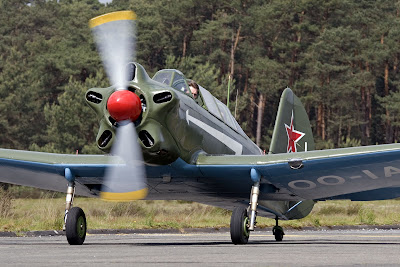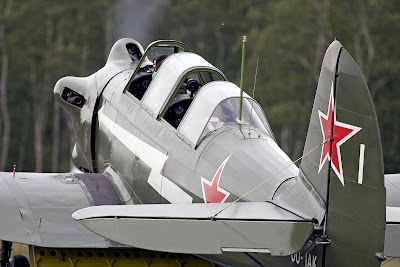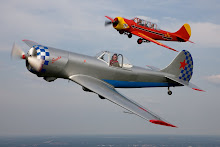blog: Yak-18 added to the Foundation
June 12 was D-Day, the Yak-18 was airborne for the first time since a long time. Jean Micheal is a proud man, and he should be, what a beauty!
The Yak-18 prototype was nicknamed “MAX” by the NATO and has flown for the first time back in 1945. It was the concept for several military trainers. The Yak-18, which became the standard trainer for Air Force flying schools and DOSAAF, is in wide use in China, Poland, Russia, and in many other countries.
Revisions of the Soviet Union's basic Yakovlev UT-2M trainer in 1943 included the enclosing of the tandem cockpits and the replacement of a tailskid with a tailwheel. The new variant, designated the UT-2MV, provided the basis for the Yak-18 prototype, first flown in 1945, when the dust of the last WWII battle had hardly settled. With an all-metal structure and mixed fabric/metal covering, the aircraft went into production in 1947, with a comparatively small engine. Built in large numbers as a "tail dragger," the plane was redesigned as the Yak-18U in 1955, with increased wing dihedral, longer fuselage and partially-retractable tricycle landing gear, for use as a jet pilot primary trainer. Despite significantly increased weight, the plane used the same old Shvetsov M-11FR radial engine as the prototype, with predictably disappointing performance. But after it was given a new engine, the 260hp Ivchenko AI-14R radial, in a revised cowling, it served for many years as the primary trainer in the Soviet Union and many client nations, under the designation Yak-18A. There were other variants, sometimes in quantity, such as the Yak-18P, a single-seat aerobatic aircraft that first flew in 1961.


General characteristics
- Crew: two, student and instructor
- Length: 8.35 m (27 ft 5 in)
- Wingspan: 10.60 m (34 ft 9 in)
- Height: 3.35 m (11 ft 0 in)
- Wing area: 17.8 m² (191 ft²)
- Empty weight: 1,025 kg (2,255 lb)
- Loaded weight: kg (lb)
- Max takeoff weight: 1,320 kg (2,904 lb)
- Powerplant: 1× Ivchenko AI-14RF radial, 224 kW (300 hp)
Performance
- Maximum speed: 300 km/h (187 mph)
- Range: 700 km (436 miles)
- Service ceiling 5,060 m (16596 ft)
- Rate of climb: ........m/s (......ft/min)
- Wing loading: .....kg/m² (......lb/ft²)
- Power/mass: ......kW/kg (......hp/lb)
Manufacture of the Yak-18 trainer was suspended in 1967 with 6,670 of all versions built, many for export. However, in that same year, production was begun on a significant redesign, the Yak-18T, which was virtually a new machine, a four-place sport/touring aircraft, with side-by-side seating for the pilot(s) and passengers. Production of the Yak-18T continued into the 1980's, with more than 1,000 built. Like many popular aircraft, the Yak-18T has a certain Phoenix-like quality. Thus, the independently operated Smolensk aircraft factory resumed roduction of the plane in 1993.
Back in 1998 Jean Michel Legrand, Airbus captain at Sabena Airline, became interested with vintage aircraft. A friend of Jean Michel told him that he knew of a wreckage of a Yak-18 at a former airspace base in Baikonour Russia. After getting the parts of what once used to be a Yak-18 into Poland, they started to work on the project. Finding the missing parts was the most difficult part of the project. Fortunately, many CJ5 parts actually fit quite nice. In Poland, Woicheck Gorzyck of DuskaAir in Wroclaw masterminded the restoration. Most of the work was actually done in it’s own home, housing the fuselage in the hallway, wings in the basement and engine parts in the living. it was always very special to visit the project, says Jean Michel.
Gorzyck’s dad, who used to be a mechanic at Yak-18’s during the cold war in the Polish air force, loved the project and volunteered his assistance. His experience was worth gold.
Early 2008, the project was about to be finished and the aircraft was transported to Belgium where it has been assembled. June 7, al paperwork was finished, June 12, the aircraft went airborne again after having been earth-bound for a long long time. Great job Jean Michel!
In the future this Yak-18 will be presented at many events, flown by Jean Michel. Keep visiting our website for the schedule.






1 Comments:
At 5:15 am, Jim said…
Jim said…
Congradulations, you did an absolutely beautiful job on your plane, I really enjoyed the story as well. Thank you for sharing.
Best Regards
Jim Selby Jr
Post a Comment
<< Home